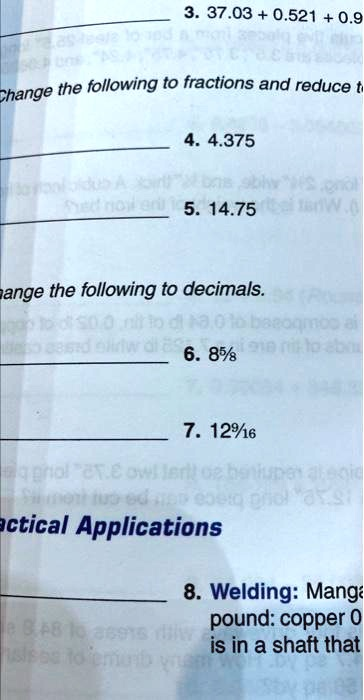37.03 + 0.521 + 0.9 Change the following to fractions and reduce t 4. 4.375 5. 14.75 mange the following to decimals. 6. 85/8 7. 129/16 actical Applications 8. Welding: Manga pound: copper 0 is in a shaft that

The Correct Answer and Explanation is:
Problem 3
Expression: 37.03 + 0.521 + 0.9
Answer: 38.451
Explanation:
This is a simple addition of decimals. You align the decimal points and add the numbers:
- 37.03
- 0.521
- 0.900
When added, the total is 38.451. Always line up the decimals vertically when adding, and if needed, add trailing zeros to make all numbers have the same number of decimal places for clarity.
Problem 4
Convert to Fraction: 4.375
Answer: 4 3/8
Explanation:
First, separate the whole number and the decimal part. The whole number is 4. The decimal part is 0.375, which is equal to 3/8 because:
- 0.375 = 375/1000
- Simplify 375/1000 by dividing both the numerator and denominator by 125:
375 ÷ 125 = 3
1000 ÷ 125 = 8
So, 0.375 = 3/8. Therefore, 4.375 = 4 3/8.
Problem 5
Convert to Fraction: 14.75
Answer: 14 3/4
Explanation:
Break 14.75 into 14 and 0.75. The decimal 0.75 is equal to 3/4 because:
- 0.75 = 75/100
- Simplify 75/100 by dividing by 25:
75 ÷ 25 = 3
100 ÷ 25 = 4
So, 0.75 = 3/4. Therefore, 14.75 = 14 3/4.
Problem 6
Convert to Decimal: 85/8
Answer: 10.625
Explanation:
To convert a fraction to a decimal, divide the numerator by the denominator:
- 85 ÷ 8 = 10.625
This decimal represents a mixed number where 85/8 = 10 and 5/8. Since 5 ÷ 8 = 0.625, the final result is 10.625.
Problem 7
Convert to Decimal: 129/16
Answer: 8.0625
Explanation:
Divide 129 by 16:
- 129 ÷ 16 = 8.0625
This can also be seen as 8 and 1/16. The fraction 1/16 = 0.0625, so the complete decimal is 8.0625.
In mathematics, understanding conversions between decimals and fractions is crucial because it allows for flexibility in solving problems, especially in practical applications like construction, engineering, or trades such as welding and machining. Fractions are often easier to measure or visualize in physical space, while decimals are better suited for calculations and digital displays. Being fluent in both forms ensures accuracy and efficiency. For example, in welding or machining, where precision is important, a tiny error in decimal or fraction interpretation can result in defective parts or unsafe assemblies. Hence, being able to switch easily between representations is a fundamental skill in technical fields.
